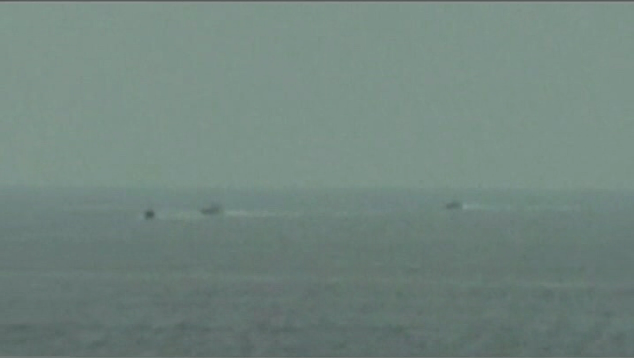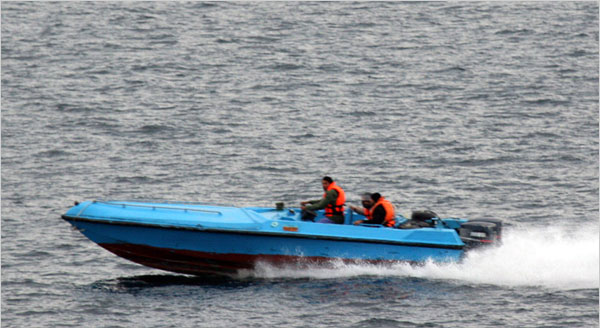Lucaites at No Caption Needed has posted an interesting analysis of the recent dustup between the U.S. and Iran in the Strait of Hormuz. According to Lucaites, the argument that the Bush administration has tried to make about the incident through the images—photos and video—released by the U.S., “relies upon two optics or visual logics, one drawing upon a Cold War consciousness and the other drawing upon the logic of the ‘suicide bomber.’ ”
 The Cold War optic recalls the ability of the modern, technologically sophisticated, military to observe the world from afar as a means of identifying and assessing threats to national security. Think here of Adlai Stevenson challenging Ambassador Zorin of the USSR with satellite photographs of missile silos in Cuba in 1962. Or more recently, of course, we have Colin Powell using similar photographic evidence to prove the existence of WMDs in Iraq. One case turned out to be true, the other false, but what is important is the underlying assumption of the positive truth content of such visual evidence which presumes to show what otherwise could not be seen. Of course, this is nonsense. Nevertheless, recent videotape from the Gulf of Hormuz operates in precisely this optic. Shot at great distance, we never actually see individuals, let alone incontrovertibly threatening behavior, but that actually works in the favor of the underlying optic of the Cold War logic, for in a sense it is what cannot ordinarily be seen that is the threat, and so the speed boats function as a cipher for a presumably hidden, greater menace.
The Cold War optic recalls the ability of the modern, technologically sophisticated, military to observe the world from afar as a means of identifying and assessing threats to national security. Think here of Adlai Stevenson challenging Ambassador Zorin of the USSR with satellite photographs of missile silos in Cuba in 1962. Or more recently, of course, we have Colin Powell using similar photographic evidence to prove the existence of WMDs in Iraq. One case turned out to be true, the other false, but what is important is the underlying assumption of the positive truth content of such visual evidence which presumes to show what otherwise could not be seen. Of course, this is nonsense. Nevertheless, recent videotape from the Gulf of Hormuz operates in precisely this optic. Shot at great distance, we never actually see individuals, let alone incontrovertibly threatening behavior, but that actually works in the favor of the underlying optic of the Cold War logic, for in a sense it is what cannot ordinarily be seen that is the threat, and so the speed boats function as a cipher for a presumably hidden, greater menace.
 In this instance, the threat that can’t be seen is animated by the more contemporary optic of the “suicide bomber.” Suicide bombers operate in the light of day, not the cloak of darkness (as was the myth of the Cold War spy). They can be anyone, and indeed, their very visibility makes them effectively invisible (hidden in plain sight), and thus all the more a threat. Add to this the discursive connection between “suicide bombers” and “Middle Eastern Islamic fanatics” and the picture of the speed boats takes on a somewhat different resonance. All the more so in the wake of the terrorist attack on the U.S.S. Cole perpetrated by Al-Qaeda, a self-professed terrorist organization, in 2000. And to accentuate the point the U.S. Navy added an audio recording to its version of the videotape that has someone threatening to bomb the Hopper. We are now told that the Navy doesn’t know where that voice came from and, indeed, cannot confirm that it came from the speedboats. And more recent videotape released by the Iranian government suggests that it is unlikely that it came from the speedboats. But, again, the point is that the photographs are framed within the optic of the suicide bomber that encourages the viewer to see the ordinary and everyday as threats.
In this instance, the threat that can’t be seen is animated by the more contemporary optic of the “suicide bomber.” Suicide bombers operate in the light of day, not the cloak of darkness (as was the myth of the Cold War spy). They can be anyone, and indeed, their very visibility makes them effectively invisible (hidden in plain sight), and thus all the more a threat. Add to this the discursive connection between “suicide bombers” and “Middle Eastern Islamic fanatics” and the picture of the speed boats takes on a somewhat different resonance. All the more so in the wake of the terrorist attack on the U.S.S. Cole perpetrated by Al-Qaeda, a self-professed terrorist organization, in 2000. And to accentuate the point the U.S. Navy added an audio recording to its version of the videotape that has someone threatening to bomb the Hopper. We are now told that the Navy doesn’t know where that voice came from and, indeed, cannot confirm that it came from the speedboats. And more recent videotape released by the Iranian government suggests that it is unlikely that it came from the speedboats. But, again, the point is that the photographs are framed within the optic of the suicide bomber that encourages the viewer to see the ordinary and everyday as threats.
Related: “I don’t give a damn about Paris Hilton”, Photo Op, A Compendium of the Visual Tropes of War, Analysis of political campaign posters, There's Enargeia and then there's *Enargeia*
Recent comments
2 years 29 weeks ago
2 years 44 weeks ago
2 years 44 weeks ago
2 years 50 weeks ago
3 years 4 weeks ago
3 years 4 weeks ago
3 years 4 weeks ago
3 years 6 weeks ago
3 years 6 weeks ago
3 years 6 weeks ago